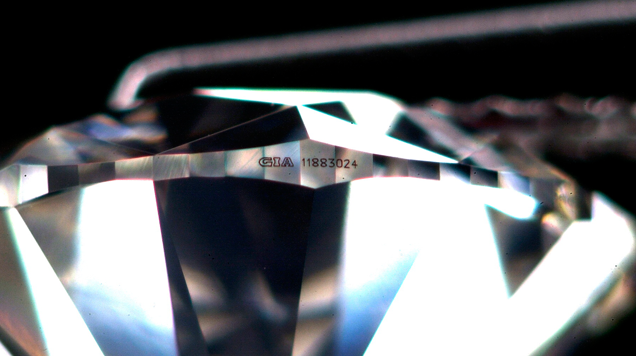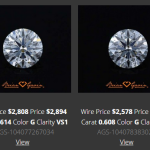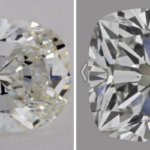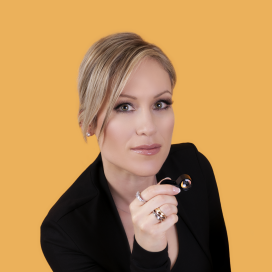The Diamond Girdle – What It Is and Why It Matters
The diamond girdle is an often missed characteristic when it comes to evaluating a diamond’s cut, but it is one of the most important. The girdle is the outer edge or perimeter of a diamond that divides the upper portion (crown) from the lower portion (pavilion) and is referenced either as words or as a percentage of the diameter; depending on what lab report you are reading. In terms of cut quality, the diamond girdle is further evaluated as part of a diamond’s overall proportions and symmetry.
The diameter and thickness of the girdle helps to distinguish proportions (relationship between the sizes and angles of various facets). When looking at any proportion diagram on a lab report, the girdle is always 100% (it is used as the basis for proportion descriptions). In round diamonds, this is the average of the minimum and maximum diameter for rounds, or the width for fancy shapes.

Example of GIA lab report inscription on the faceted girdle of a round brilliant diamond. Note the ‘peaks’ and ‘valley’s of the girdle, which is used to characterize the minimum and maximum girdle thickness. (photo credit: GIA Gem Lab Service)
Girdle Finish – Bruted, Polished, and Faceted
A diamond girdle can have three different finishes including bruted, polished and faceted. A bruted girdle has a matte finish and feels a little like finely ground sandpaper to the touch. The girdle can also be polished to a high shine with a smooth finish. However, the most desirable finish is the faceted girdle as it contains many small individual facets further helping to reflect light and matching the overall appearance of the other surface facets. Keep in mind that fancy shaped diamonds with straight sides (princess or emerald shape for example) have a girdle that is often polished and not faceted.
A bruted girdle is uncommon with modern cut diamonds but you may find the rare example. It does not lower a diamond’s overall grade but can be unsightly when found in excessively thick girdles which can be quite distinct from the other polished faceted surfaces of the diamond.
Diamond Girdle Size – Extremely Thin, Very Thin, Thin, Medium, Slightly Thick, Thick, Very Thick, and Extremely Thick
The diamond girdle size and symmetry tells us a lot about the overall cut quality of a diamond and therefore should be an integral part of your evaluation process. Girdle thickness is measured around the full circumference of the stone and is listed with the minimum and maximum girdle thicknesses, for example thin to slightly thick.
The best diamond girdle thickness is Thin, Medium, or Slightly Thick Click To TweetThe reason why girdle thickness is so important is because an extremely thin girdle (often referred to as ‘knife edge’) can lead to vulnerability as the stone has a higher propensity of being damaged (fractured, chipped, cleaving, etc.). It is a big deal and therefore an excessively thin girdle should be avoided, no matter the cost or the apparent price deal of a diamond. Conversely, an excessively thick girdle retains carat weight and the diamond will look small for it’s size. This essentially means that you could purchase a 1.00ct diamond with an extremely thick girdle but the diamond visually looks more like a .85ct. (Remember, carat weight is not an indicator of size!)
Diamond Girdle Symmetry – Off-Round, Wavy Girdles, Tilted Tables
The ‘Symmetry’ characteristic referenced on lab reports pertains to the “neatness” of facet intersections as well as external placement. There are many different factors that come into play here but with regard to the girdle, there are three major symmetry faults that we can sometimes see: ‘out-of-round’ diamonds, wavy girdles, and tilted tables.
It is often difficult to get a perfectly round diamond, but from a visual perspective a round brilliant diamond should appear ’round’ to the naked eye. If the diamond appears slightly off, this is referred to as an off-round or out-of-round and is considered a major symmetry fault. Fancy cut diamonds are evaluated by the shape of the outline which should be even.
A wavy girdle occurs when the girdle does not remain at an even distance from the table from all points of the circumference of the diamond. This is not the same thing as a change in girdle thickness and is best seen when viewing the diamond from it’s side profile.
A girdle that is not parallel to the table is called a tilted table. These are often difficult to distinguish from a wavy girdle and therefore considered under the same symmetry fault.
Diamond Girdle and Clarity Characteristics – Naturals, Bearding, and Extra Facets
A common external blemish called a ‘natural’ is often found on a girdle of a diamond. Naturals are a remnant of the original rough surface of the diamond and are often kept for weight retention or in special cases purposely kept on the girdle to prove natural origins of the diamond as in the case of fancy green diamonds. If a natural is confined to only the girdle it is not considered a clarity flaw and they are not visible without magnification.
Bearding on a diamond’s girdle occurs when the diamond is bruted or rounded in shape as part of the initial cut process. Too much pressure applied during the bruting (rounding) process causes tiny fractures to extend from the girdle into the diamond. This is considered an internal flaw or inclusion and is often seen in antique diamonds that have been around for sometime (another reason why I recommend buying a diamond with a lab report no older than 3 years).
An extra facet is most commonly found just under the girdle on the pavilion facets and is usually added to hide a surface defect or when two adjacent facets do not align during faceting. Extra facets have no impact on clarity grade.
Diamond Girdle and Identification
Most of today’s modern cut diamonds have the lab report inscribed on the girdle of the diamond. This serves both as confirmation of goods received as well as identification for any future repair or appraisal service. Some labs will inscribe a short personal message on the diamond girdle to commemorate a special occasion or experience. Inscriptions on the diamond girdle are microscopic and cannot be seen with the unaided eye.
If you have any questions about a diamond’s girdle or would like personal advice/recommendations, please don’t hesitate to contact me. I look forward to hearing from you!
Happy Diamond Buying!
Hey.You Want Ideal Cut Diamonds?
You've got it.
Join ODBA's Diamond Deal Friday and get handpicked diamonds every week from me to you.
No consultation required. Subscribe now!
ODBA Recommends
You May Also Like







